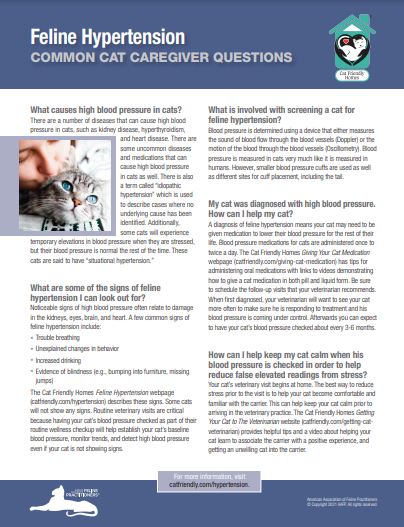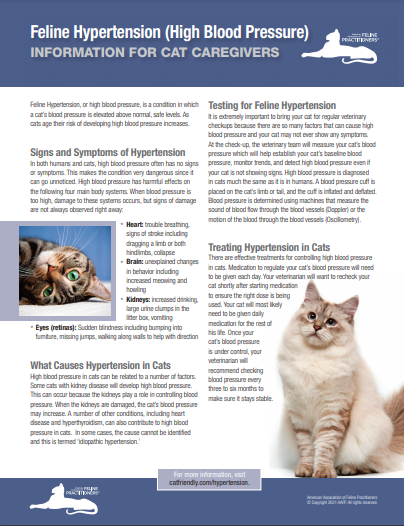Feline Hypertension, or high blood pressure, is a condition in which a cat’s blood pressure is elevated above normal, safe levels. As cats age their risk of developing high blood pressure increases.
Signs and Symptoms of Hypertension
In both humans and cats, high blood pressure often has no signs or symptoms. This makes the condition very dangerous since it can go unnoticed. High blood pressure has harmful effects on the following four main body systems. When blood pressure is too high, damage to these systems occurs, but signs of damage are not always observed right away:
- Heart: trouble breathing, signs of stroke including dragging a limb or both hindlimbs, collapse
- Brain: unexplained changes in behavior including increased meowing and howling
- Kidneys: increased drinking, large urine clumps in the litter box, vomiting
- Eyes (retinas): Sudden blindness including bumping into furniture, missing jumps, walking along walls for direction
What Causes Hypertension in Cats
High blood pressure in cats can be related to a number of factors. Some cats with kidney disease will develop high blood pressure. This can occur because the kidneys play a role in controlling blood pressure. When the kidneys are damaged, the cat’s blood pressure may increase. A number of other conditions, including heart disease and hyperthyroidism, can also contribute to high blood pressure in cats. In some cases, the cause cannot be identified and this is termed ‘idiopathic hypertension.’

Testing for Feline Hypertension
It is extremely important to bring your cat for regular veterinary checkups because there are so many factors that can cause high blood pressure and your cat may not ever show any symptoms. At the checkup, the veterinary team will measure your cat’s blood pressure which will help establish your cat’s baseline blood pressure, monitor trends, and detect high blood pressure even if your cat is not showing signs. High blood pressure is diagnosed in cats much the same as it is in humans. A blood pressure cuff is placed on the cat’s limb or tail, and the cuff is inflated and deflated. Blood pressure is determined using machines that measure the sound of blood flow through the blood vessels (Doppler) or the motion of the blood through the blood vessels (Oscillometry).
Treating Hypertension in Cats
There are effective treatments for controlling high blood pressure in cats. Medication to regulate your cat’s blood pressure will need to be given each day. Your veterinarian will want to recheck your cat shortly after starting medication to ensure the right dose is being used. Your cat will most likely need to be given daily medication for the rest of his life. Once your cat’s blood pressure is under control, your veterinarian will recommend checking blood pressure every three to six months to make sure it stays stable.
Monitoring
All senior cats should be screened every six months at their checkups for increases in their blood pressure. It is recommended to check all cats’ blood pressure during their regular checkups so they can become comfortable having a cuff inflated on their limbs or tail. If your cat is on medication for high blood pressure, your veterinarian will recommend testing his blood pressure every three to six months. Blood pressure readings should be taken by your veterinarian using validated equipment. Commercial monitors purchased for human or pet at-home-use are not considered reliable and should not be used.



